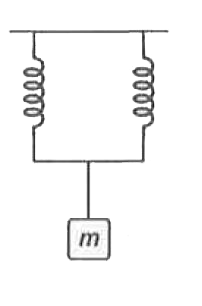Two springs are joined & attached to a mass of 16 kg. The system is then suspended vertically from a rigid support. The spring constants of the two springs are — K1 & K2 respectively. The period of vertical oscillations of the system will be -Solution in Bengali
18π√K1+K2
8π√K1+K2K1K2
π2√K1−K2
π2√K1K2
Step by step video & image solution for Two springs are joined & attached to a mass of 16 kg. The system is then suspended vertically from a rigid support. The spring constants of the two springs are — K_(1) & K_(2) respectively. The period of vertical oscillations of the system will be - by Physics experts to help you in doubts & scoring excellent marks in Class 12 exams.
Updated on:21/07/2023Topper's Solved these Questions
Similar Questions
The coefficient of volume expansion of a liquid is γ and its density at 0∘C is ρ. If the temperature is increased to t∘C then the change in density will be
View Solution→Aand→B are two vectors given by →A=2ˆi+3ˆjand→B=ˆi+ˆj. The magnitude of the component of →A along →B is
View SolutionTwo spring of spring constant k_(1) and k_(2) are joined in series The effective spring constant of the combination is given by
View SolutionTwo spring have force constants k_(1) and k_(2) respectively. They are attached to a mass m and two fixed supports as shwon in figure. If the surface is frictionless, fing the time period of oscillations. What is the spring factore of this combination.
View SolutionA mass m is suspended from the two coupled springs connected in series. The force constant for springs are k1andk2. The time period of the suspended mass will be
View SolutionTwo springs of spring constants K_(1) and K_(2) are joined in series. The effective spring constant of the combination is given by
View SolutionA mass is suspended separately by two springs of spring constants k1 and k2 in successive order. The time periods of oscillations in the two cases are T1 and T2 respectively. If the same mass be suspended by connecting the two springs in parallel, (as shown in figure) then the time period of oscillations is T. The correct relations is

View SolutionA system consists of two spring and a mass m = 1 kg as shown in figure . If mass m is dispalced slightly along vertical and vertical and released. The system oscillates with a period of 2 s .Then , the spring canstant K is

View SolutionTwo springs are joined and attached to a mass of 16 kg. The system is then suspended vertically from a rigid support. The spring constant of the two spring are k1andk2 respectively. The period of vertical oscillations of the system will be
View Solutionदो स्प्रिंगों को आपस में जोड़कर उनसे 16 किग्रा द्रव्यमान जोड़ा गया है। इस निकाय को दृढ़ समतल से ऊर्ध्वाधर रूप से लटकाया गया है। यदि स्प्रिंगों के स्प्रिंग नियतांक क्रमशः k1 व k2 है तो निकाय के ऊर्ध्वाधर दोलनकाल का मान होगा
View SolutionTwo light springs of force constants k_(1)andk_(2) are connected one after another and suspended from a rigid support. A body of mass m is hung from the free end of the spring system. Determine the time period of vertical oscillation of the body.
View Solutionएक द्रव्यमान m समान लम्बाई की दो स्प्रिंगों से लटका हुआ है। स्प्रिंगों के बल नियतांक क्रमशः k1 व k2 हैं। जब पिण्ड को ऊर्ध्वाधर दिशा में दोलन कराया जाता है तो इसका आवर्तकाल होगा

View SolutionTwo springs of spring constant k1 and k2 are joined in series. Hence its equivalent spring constant of the combination is…………
View SolutionTwo springs are joined and attached to a mass of 16 kg. The system is then suspended vertically from a rigid support. The spring constant of the two springs are K_(1) and K_(2) respectively. The period of vertical oscillations of the system will be:
View SolutionA mass is suspended separately by two springs of spring constants k_(1) and k_(2) in successive order. The time periods of oscillations in the two cases are T_(1) and T_(2) respectively. If the same mass be suspended by connecting the two springs in parallel, (as shown in figure) then the time period of oscillations is T. The correct relations is
View Solution
